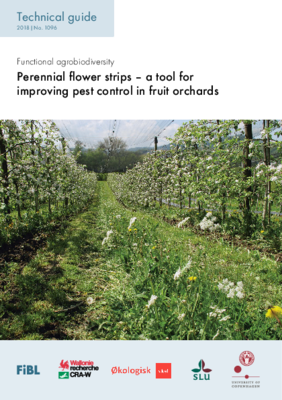Pests can lead to yield losses and quality losses in organic fruit production. The pesticides available are not always sufficient to control the pests. Therefore, additional measures are necessary to achieve the high production targets. The sustainable promotion of natural antagonists can make a decisive contribution to pest control. Within the framework of the 3-year international project 'EcoOrchard', the effect of perennial flower strips on beneficial insects such as predatory insects, spiders and parasitoids in apple orchards and pest infestation was investigated in detail in seven countries and management measures were developed.
Perennial flower strips considerably improve plant diversity and the supply of nectar and pollen for beneficial organisms. This significantly increases the effectiveness of biological pest control by predators and parasitoids. Up to 38 % more natural enemies of aphids were found on flower clusters (pre flowering), fruitlet clusters (after flowering) or long shoots (after the second fruit drop) of apple trees with adjacent flower strips compared to trees without flower strips. The percentage of apples damaged by the Rosy apple aphid was 15 % lower in trees next to flower strips compared to trees in the control plots. With well-developed and well-managed flower strips, an average of 1-2 insecticide treatments can be avoided in fruit orchards. This saves pesticides and costs, reduces residues on the fruits and lowers the impact on the environment. However, reliable information on the optimum care of the drive alleys and the tree rows and on the harmonisation of the plant protection regime with the promotion of beneficial insects and pollinators is still lacking. These questions will be answered in a next research project.
The results of the EcoOrchard project were edited for practical use in a 16-page leaflet. The technical guide explains how the flower strips work, introduces suitable plants and describes the procedure for planting and managing the flower strips. The information is complemented by information on the costs and possible disadvantages of the flower strips. The publication is available as a paid print version or as a free download.
Further information
Contact
Links
- shop.fibl.org: Technical guide "Perennial flower strips – a tool for improving pest control in fruit orchards"
- projects.au.dk: EcoOrchard-Project




